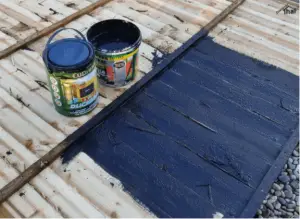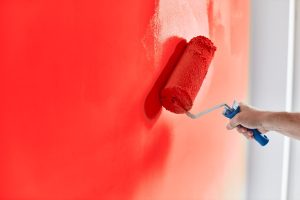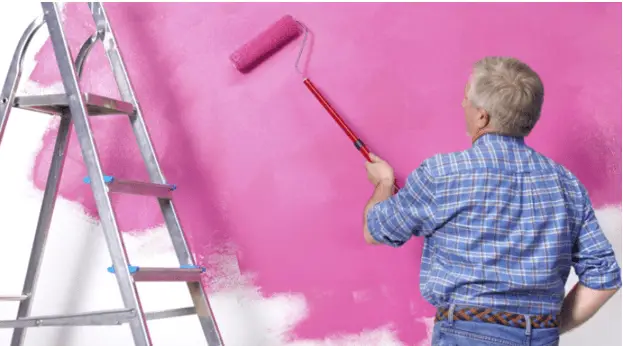You might think that your finished painting looks different from the actual paint after it dries. This happens not only in your case; most painters face this confusion.
There are many reasons why your painted walls look lighter or darker after drying. The surface temperature of your paint and the type of paint that you use can impact your paint look.
Typically, if your wall has previous light paint or light colors surrounding the paint, the paint looks darker. Besides, glossy colored finishes look darker as the light is reflected from the surface to create a darker appearance.
On the other hand, your paint will look lighter when it absorbs light. Read this article to know in detail how the paint changes color when it dries.
Does Paint Dry Darker Or Lighter?

Quality paint doesn’t dry lighter or darker. When applied, the paint looks lighter or darker than expected, but quality paint constantly switches to the actual color after it completely dries. Paints such as acrylic, oil, and latex generally look darker than the color after drying that is initially applied.
In addition, when you mix paints properly, the final color looks lighter when the paint dries properly. Keep in mind paints will require up to eight hours to dry.
Besides, paint dry time could vary depending on paint quality. So, if you find any difference in the color of the paint, make sure you wait until the paint is entirely dry.
However, you will not get your desired paint color when you mix two different brands of paint. You have to always mix the same paint brand to ensure the proper print color.
In that case, you can first check the color of paint in an obscure area and let it dry completely. This helps you know whether your mixture paint will appear your desired color.
Further Watching:
How Does Paint Color Change When Dry

Several factors impact the paint color when it dries. Some may not give enough coats, don’t mix properly, and many more things. Below we have shown some significant factors that impact the paint color’s appearance as it dries.
Finish
Different paint finishes make different looks. If you have a gloss finish over a larger area, it may appear darker than you expected. This is because the light is reflected by that type of paint. On the other hand, an eggshell or matte finish may appear closer to the switch color you chose.
Furthermore, flat paint has a chalkier appearance and lacks the sheen of gloss paint. Remember the different types of paint finish you choose will ensure the final look of your paint after it dries completely.
Environment
Your painting’s color can shift tone depending on its surroundings. If you want to paint an accent wall, it will be a little darker than the other walls. When you pick light gray paint, you will not see a difference while applying it to the wall. This is because the dark gray hue appears much lighter when it completely dries.
Besides, if you have any previous paint, the newly painted color will look darker than the paint’s actual color. You may end up with a lighter paint color if your painted wall is 10 degrees cooler than room temperature.
On the other hand, painting anything warm, approximately 10 degrees warmer than room temperature, may darken your final paint color.
Lighting
Lighting on the painted wall makes the paint color lighter and darker due to light reflecting. When light reflects more on the wall, the paint color appears brighter.
You will be able to brighten other surrounding objects in your room when you do this. So, if you don’t find the actual paint color, try positioning the light source differently.
How Psychological Factors Influence Paint Color After It Dries?
Psychological factors also impact the painted color and the actual paint. Here we have outlined such psychological factors that may play tricks on you.
Metamerism
Metamerism is a scientific term that can have an instance in your life. Usually, it is a psychophysical phenomenon that shows you different colors in different circumstances.
For example, you automatically compare surrounding colors and shades when choosing any paint. For that, we typically look at the next color chat on a corresponding color instead of an individual color.
Comparison
Sometimes we psychologically compare paint to what the wall is presently painted. As a result, the original color will automatically change in our eyes just like holding a paint chip under a red or yellow wall.
This is another impact of metamerism. In that case, you can look at a color against a white background for the actual representation of your color selection.
Which Types Of Paint Are Mostly Dry Lighter And Darker?
Paint has a funny power that makes any wall dry darker, or brighter. For your convenience, below, we have demonstrated which paints are darker and brighter after drying.
Paints Mostly Dry Darker
Typically, oil, acrylic, and latex paints can dry dark in tone. A double coat is always recommended to ensure adequate paint adhesion regardless of the material or color.
Although one coat may make a dark shade, two coats are crucial to achieving a standard and even appearance. In addition, glossy and semi-glossy paints are usually perfect for drying darker.
When light reflects on these paints, it creates a false depth and darker them. Sometimes latex paints appear one looks when you first open the can. But when you apply it to a wall, it can be slightly darker than expected.
So, the color of the paint depends entirely on using style, environment condition, and ingredients type.
Paints Mostly Dry Lighter
Cream and white-shade paints typically look lighter when dry. In fact, these paints are naturally made to appear light. Also, when you mix a lot of water with watercolor, it looks light after it dries completely. So, if you want lighter colors in your water paints, add more water.
This way, you can easily change how bright or dark your paint color becomes. However, the look of your final color will change for three reasons: light reflection, color shade, and moisture.

Tips For Avoiding Darker Or Lighter Than Expected Paint
Here we have pointed out some tips that will help you to avoid darker or lighter than your expected paint color. You can consider these tips while painting anything.
- Always try to use quality paint because regular paints change the paint color when dry.
- While painting anything, ensure the environment temperature is above 60 degrees Fahrenheit.
- Before applying the main coat of any paint, always use a primer.
- Ensure the painting environment’s humidity is under 70% and probably approximately 50%.
- Stir your paint properly before using it.
- Avoid touching up the paint and repaint if necessary.
Read More:
How To Remove Paint From Concrete: The Easy Way
How to Get Rid of That Annoying Paint Smell
Conclusion
Different types of paint have different properties. As a result, all paint colors look different when dry completely. Usually, the paint will dry darker than the color when initially applied. For this reason, most painters have been confused about how paint colors change when dry.
That’s why we have presented adequate information about paints in this context. Typically, there are several reasons behind the color change of your paint when dry.
Paint type, surface temperature, lighting and colors in the room, and paint’s finish are among the factors that affect painting looks.

